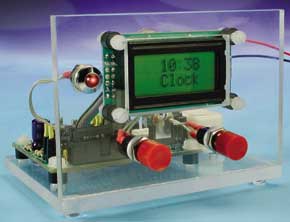Multi-event Alarm Clock
In control of many daily events

This is a MEMBER ONLY article. You need a subscription to read this article.
- Unlimited access to online Member Only articles
- 3 new editions Elektor Magazine (digital)
- More than 5000 Gerber files
- 20% member discount on e-books (at elektor.com)
- 10% member discount on Products (at elektor.com)
Available from €5.33 per month.
What is Members Only
Elektor is committed to providing high-quality content on electronics, catering to tens of thousands of paying members. As part of this commitment, Elektor has launched Premium, an initiative that offers exclusive online articles to members sometimes even before they appear in the magazine.
Every day, members can access in-depth articles that showcase the best of Elektor's premium content.
This initiative aims to reward members with early access. Once logged in, members can easily enjoy this exclusive content and engage in discussions about featured projects. While Premium adds to the existing resources available, Elektor will continue to provide a wealth of free information.
Join the Elektor community today to take advantage of Premium and other benefits!
Materials
Gerber file
CAM/CAD data for the PCB referred to in this article is available as a Gerber file. Elektor GREEN and GOLD members can exclusively download these files for free as part of their membership. Gerber files allow a PCB to be produced on an appropriate device available locally, or through an online PCB manufacturing service.
Elektor recommends the Elektor PCB Service service from its business partner Eurocircuits or AISLER as the best services for its own prototypes and volume production.
The use of our Gerber files is provided under a modified Creative Commons license. Creative Commons offers authors, scientists, educators and other creatives the freedom to handle their copyright in a more free way without losing their ownership.
Component list
R1 = 1kOhm
R2,R3 = 47kOhm
R4 = 10Ohm
R5,R6,R7 = 4kOhm 7
R8 = 1Ohm 5
R9 = 100Ohm
R10 = 220Ohm
P1 = 10kOhm preset
P2 = 2kOhm 5 preset
Capacitors:
C1,C2 = 33pF
C3 = 1µF/63V radial
C4,C6,C7,C10 = 100nF
C5 = 25pF (trimmer)
C8 = 220µ F 10V radial
C9= 10µ F 63V radial
C11 = 470µ F 16V radial
Semiconductors:
D1 = LED, red, 5mm, low current (optionally with chassis-mount holder)
D2 = 1N4001
T1 = BC547B
T2 = BD242
T3 = BC557C
T4 = BF256C
IC1 = AT89C2051-12PC, programmed, order code 020304-41
IC2 = DS1307
IC3 = 4805
Miscellaneous:
JP1 = 3-way pinheader with jumper
S1,S2 = pushbutton, 1 make contact, chassis mount
LCD1 = LC display, 16 characters (2 lines x 8), e.g. AV0820 from Anag Vision) plus 16-way boxheader
X1 = 6MHz quartz crystal (parallel resonance)
X2 = 32.768 kHz quartz crystal
BT1 = 3V Lithium cell type CR2032 with PCB mount holder (22.75mm diam.)
BT2 = see text
BZ1 = 5V or 6V DC buzzer (active piezo)
PCB, available from The PCB Shop
Disk, microcontroller C (source) and hex files, order code 020304-11 or Free Download



Discussion (0 comments)